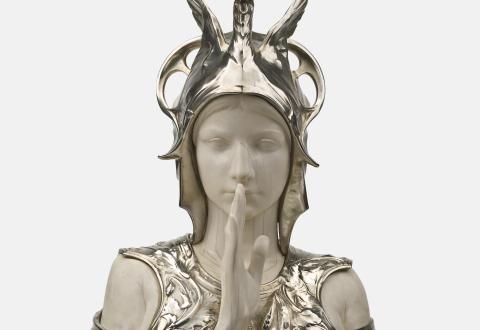Highlights of these styles are currently displayed in the so-called Wolfers shop. In June 2025, as part of Art Deco Brussels 2025, there will be a rearrangement, with an additional 1,200-square-foot room housing the furniture and decorative arts of Belgian art nouveau and art deco. The eye-catcher will be a restored and refurbished winter garden based on the design of Victor Horta.
Wolfers shop
Designed by the famous Art Nouveau architect Victor Horta, the new premises of the business of the famous goldsmith jeweller Wolfers Frères in the rue d’Arenberg, Brussels were officially inaugurated on 4 November 1912 and were home to the Wolfers’ business until 1973. Subsequently, the shop furnishings were dismantled and gifted by the Wolfers family to the Museum, where they were set up in a minimal display. In 2017 the shop has been reconstituted, but now in a museum room whose form and size is virtually identical to the original space for which Horta designed the furniture. However, the...
Designed by the famous Art Nouveau architect Victor Horta, the new premises of the business of the famous goldsmith jeweller Wolfers Frères in the rue d’Arenberg, Brussels were officially inaugurated on 4 November 1912 and were home to the Wolfers’ business until 1973. Subsequently, the shop furnishings were dismantled and gifted by the Wolfers family to the Museum, where they were set up in a minimal display. In 2017 the shop has been reconstituted, but now in a museum room whose form and size is virtually identical to the original space for which Horta designed the furniture. However, the reconstitution has not been limited to the showcases, but has also been extended to the original layout and the original colour scheme, as determined by Horta. The most luxurious shop that Horta ever designed can now be seen again in all its glittering allure, as it was in its heyday.

Art Nouveau & Art Deco
Within the reconstituted shop, exceptional works of art from the historical Art Nouveau and Art Deco collections of the Museum have been deployed to help recount the story of Wolfers Frères. Indeed, the Museum boasts by far the most important collection of decorative art from those two art styles. The works in that collection all of the most outstanding quality were acquired as new creations at major exhibitions, often directly from the respective artists themselves.

Contact
Werner Adriaenssens
w.adriaenssens@kmkg-mrah.be